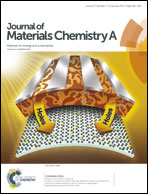The electrocapacitive properties of hierarchical porous reduced graphene oxide templated by hydrophobic CaCO3 spheres†
Abstract
The hard template approach for preparing porous materials allows one to be able to control pore size and particle morphology. However, the cost of this method is a crucial factor for mass production. In this work, commercially available low-cost hydrophobic CaCO3 spheres (HCS) of different particle sizes were used as hard templates for preparing porous reduced graphene oxide (RGO). Nitrogen physisorption, field-emission scanning electron microscopy and transmission electron microscopy images, and the electrochemical impedance spectroscopy technique revealed that the HCS acted as a template to generate hierarchical pores in the resultant RGO. A porous RGO sample with a specific surface area of 540 m2 g−1 templated by HCS with an average diameter of about 50 nm exhibited a gravimetric charge–discharge capacitance of 201 F g−1 at a current density of 0.1 A g−1. After 1000 continuous cycles, the electrode retained about 98.4% of its initial capacitance. This HCS template method provides a viable and inexpensive route to mass production of graphene-based porous materials for electrochemical energy storage.


 Please wait while we load your content...
Please wait while we load your content...